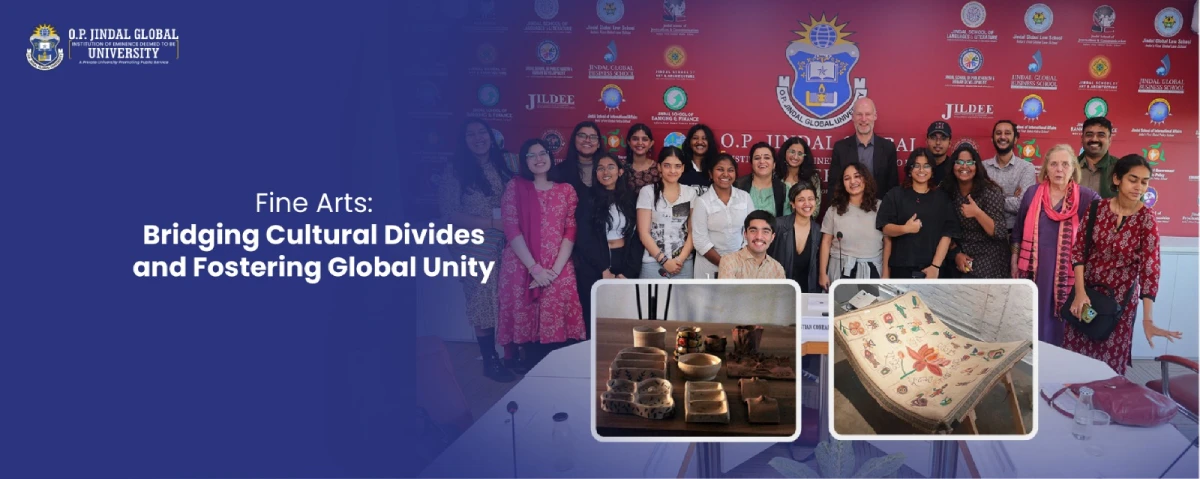Table of Contents
What Is Fine Arts?
Fine arts encompass an expansive spectrum of expressive forms, ranging from the visual arts like painting, sculpture, and photography to the performing arts such as music, dance, and theatre, as well as literary pursuits like poetry and prose. These artistic endeavours are distinguished by their pursuit of aesthetic beauty, innovation, and emotional resonance, serving as vehicles for individuals and societies to convey, explore, and interpret the complexities of the human experience.
Rooted in history and culture, fine arts have long been revered for their ability to reflect societal values, challenge conventions, and provoke contemplation. Fine arts provide platforms for personal expression, social critique, and collective celebration, whether through evocative brushstrokes on canvas, dynamic movements on stage, or stirring melodies in symphonies. They facilitate connections across diverse cultures and perspectives, fostering empathy, understanding, and appreciation for the rich tapestry of human creativity.
In this blog, we will briefly talk about the history and nature of fine arts, its types, its scope, and why it is important. Let’s get started!
History and Nature of Fine Arts
The history of fine arts dates back to prehistoric times with cave paintings and carvings, reflecting humanity’s innate desire to depict and communicate. Ancient civilizations like Egypt, Greece, and Rome saw the development of sophisticated artistic forms, with significant achievements in sculpture, architecture, and visual arts.
During the Middle Ages, art was dominated by religious themes, while the Renaissance marked a rebirth of humanism and individual expression, exemplified by artists such as Leonardo da Vinci and Michelangelo. The subsequent centuries introduced various art movements, including Baroque, Rococo, Romanticism, Realism, and Impressionism, each contributing to the evolution of fine arts. The 20th century saw revolutionary changes with movements like Cubism, Surrealism, and Pop Art, pushing the boundaries of traditional art forms.
The nature of fine arts is characterized by its diversity and creativity, encompassing visual arts (painting, sculpture, drawing, photography), performing arts (music, dance, theatre), and literary arts (poetry, prose).
Fine arts aim to express human emotions, ideas, and experiences in aesthetically pleasing and thought-provoking ways. They evoke deep emotions, provoke critical thought, and inspire change, mirroring society and fostering cultural identity. Engaging with fine arts enhances critical thinking, problem-solving skills, and emotional intelligence, providing individuals with a means of self-expression and a deeper understanding of the world. The enduring significance of fine arts lies in their ability to captivate, challenge, and enrich our lives, embodying the essence of human creativity and expression.
Types of Fine Arts
Here are some of the most popular fields and of fine arts and fine arts subjects.
Visual Arts
This category includes painting, which involves applying pigment to a surface to create an image, expression, or representation, with styles ranging from realism to abstract. Sculpture is another form involving creating three-dimensional forms by carving, modelling, or assembling materials such as stone, metal, or clay.
Drawing, the technique of marking a surface with tools like pencils, charcoal, or ink to produce an image, also falls under this category. Printmaking is the process of creating artwork by printing, typically on paper, using techniques like etching, lithography, and screen printing. Photography, the art of capturing images using light, either on film or digitally, creates visual records or artistic compositions.
Performing Arts
Music is the art of creating and arranging sounds to produce melodies, harmonies, and rhythms, performed with instruments or the human voice. Dance involves the movement of the body, often rhythmically and to music, as an expression of emotion, storytelling, or aesthetic enjoyment. Theatre combines acting, speech, gesture, music, dance, and visual arts to convey a narrative or emotion to an audience. Film and cinema tell stories through moving images, blending elements of theatre, visual arts, music, and literature to create a powerful medium of expression.
Literary Arts
Poetry uses language to evoke emotions and create aesthetic experiences through rhythm, meter, and metaphor. Prose, written or spoken language in its ordinary form, includes novels, short stories, essays, and other narrative forms that explore human experiences and ideas.
Applied Arts
Architecture blends functionality with aesthetic principles in the design and construction of buildings and other physical structures. Design encompasses creating plans for objects, systems, or structures and includes graphic design, fashion design, interior design, industrial design, and more.
Interdisciplinary Arts
Digital arts use digital technology as an essential part of the creative process, including digital painting, computer graphics, and virtual reality. Performance art is a live presentation often combining elements of visual arts, dance, theatre, and music, emphasizing the artist’s use of their body and actions in real-time. Installation art involves creating three-dimensional works designed to transform the perception of space, often using various materials and sensory experiences.
Scope of Fine Arts
The scope of a fine arts course and this field is broad and diverse, offering numerous opportunities for personal growth, professional development, and societal impact.
Personal and Creative Development
Fine arts allow individuals to express their creativity, emotions, and ideas, enhancing critical thinking and emotional intelligence. Engaging in artistic activities fosters personal identity and continuous learning.
Educational Opportunities
Fine arts education spans from primary schools to specialized higher education, promoting creativity, cultural awareness, and appreciation for diversity. Visual arts, music, dance, theatre, and literature programs help students develop their artistic skills and knowledge.
Professional Careers
Artists can pursue careers in various fields, including painting, sculpture, photography, music, dance, theatre, and writing. The entertainment industry, art education, curation, art therapy, and arts administration offer viable career paths.
Cultural and Social Impact
Fine arts preserve and promote cultural heritage, fostering a sense of identity and continuity. Art can challenge societal norms, provoke thought, and inspire social change through public installations, performances, and exhibitions.
Economic Contributions
The fine arts sector significantly contributes to the economy by generating employment and revenue. Art galleries, museums, theatres, and cultural festivals attract tourists and support local economies while selling artworks and performances sustains artists and related businesses.
Interdisciplinary Applications
Fine arts intersect with technology, health, and social sciences. Digital arts create new forms of expression, art therapy supports mental health, and collaborations between artists and scientists lead to innovative solutions in various domains.
Explore Jindal School of Liberal Arts and Humanities
Liberal Arts and Humanities Courses

Scope of Fine Arts in India
The scope of fine arts in India is extensive and multifaceted, reflecting the country’s rich cultural heritage and dynamic contemporary art scene. Opportunities abound in cultural preservation, with restoration, curation, and heritage management roles. Educational institutions offer comprehensive programs in fine arts, nurturing future artists.
Graduates from a fine arts course can explore professional careers spanning painting, sculpture, photography, design, dance, theatre, music, art education, therapy, and administration. Fine arts play a significant role in social impact, engaging communities and promoting inclusivity. Economically, the sector supports tourism and a growing contemporary art market, while interdisciplinary digital arts, health, and sustainability applications highlight innovative collaborations. Additionally, Indian artists are gaining international recognition, enhancing global cultural exchanges.
Importance of Fine Arts
The importance of fine arts extends across various facets of individual and societal life, enriching human experience and fostering cultural development. Fine arts provide a powerful means of personal expression, allowing individuals to convey emotions, ideas, and identities through creative processes.
This expression enhances emotional intelligence, critical thinking, and problem-solving skills, contributing to personal growth and mental well-being. Culturally, fine arts preserve and promote heritage, reflecting diverse communities’ values, traditions, and histories. They foster cultural continuity and pride while challenging societal norms and inspiring social change. Public art installations, performances, and exhibitions engage communities, raise awareness about social issues, and promote inclusivity and diversity.
Economically, the fine arts sector generates significant employment and revenue. Art galleries, museums, theatres, and cultural festivals attract tourists and stimulate local economies. The sale of artworks and performances supports artists and related businesses, while the growing market for contemporary art offers financial opportunities.
Educationally, fine arts enhance learning by fostering creativity, cultural awareness, and appreciation for diversity. Art education at all levels nurtures future artists and cultivates a deeper understanding of the world.
Moreover, fine arts intersect with various fields such as technology, health, and environmental sustainability. Digital arts leverage new media, while art therapy supports mental health. Collaborations between artists and scientists lead to innovative solutions to societal challenges.
About JGU BA Fine Arts Programme
A Bachelor of Fine Arts (BFA) is a comprehensive four-year undergraduate degree program that offers in-depth and specialized training in various fields of fine arts. This program is designed to cultivate artistic talent and provide students with a broad understanding of fine arts’ theoretical and practical aspects.
The curriculum typically includes a combination of core and elective subjects that ensure a well-rounded education. Common subjects studied in a BFA program include art history, which provides insights into the evolution of art across different cultures and periods; art theory, which explores the principles and philosophies that underpin artistic practices; art criticism, which teaches students how to evaluate and interpret artworks; art appreciation, which fosters a deeper understanding and enjoyment of visual arts; and studio practice, which offers hands-on experience in creating art.
The B.F.A. (Hons.) program at Jindal School of Liberal Arts and Humanities (JSLH) is specifically designed to educate and train visual artists while encouraging students to explore additional forms of artistic practice. This holistic approach ensures that graduates are well-prepared for various career paths within the art world.
Graduates of the B.F.A. program can pursue careers as freelance studio artists, where they create and sell their own artworks; illustrators, who produce images for books, magazines, and other media; gallery artists, who exhibit and sell their work in galleries; creative designers, who work in fields such as fashion, interior design, and advertising; art historians, who study and interpret art from different periods and cultures; and art acquisition specialists, who work with museums and private collectors to acquire new works of art.
Other career options include curators, who organize exhibitions and manage art collections; gallery assistants, who support the operations of art galleries; community artists, who engage with local communities through art projects; arts marketing and business professionals, who promote and manage art-related businesses; and theatre set designers, who create the visual environments for stage productions.
The B.F.A. program equips students with a range of valuable skills, such as creativity, which enables them to generate original ideas and artworks; innovation, which allows them to develop new techniques and approaches; imagination, which fuels their ability to envision and create; problem-solving, which helps them overcome artistic and technical challenges; improvisation, which aids them in adapting to new situations and ideas; and critical thinking, which sharpens their ability to analyze and interpret art.
Frequently Asked Questions
What is fine arts and a fine arts course?
Fine arts encompass creative disciplines, including visual, performing, and applied arts. These disciplines focus on aesthetic expression and the creation of works appreciated primarily for their beauty and emotional power. A fine arts course typically includes Visual Arts, Performing Arts, and Applied Arts. Courses in fine arts often cover foundational skills, art history, techniques, and advanced specializations, providing students with both theoretical knowledge and practical experience in their chosen art forms.
What are some common job roles and career fields after a degree in fine arts in India?
After a fine arts degree in India, graduates can pursue careers as artists, graphic designers, illustrators, art directors, animators, and photographers. They can also work as sculptors, curators, art educators, critics, and writers. Additional roles include interior and fashion design, set design, conservation, and art therapy. These careers span sectors like education, entertainment, advertising, media, and healthcare.
Is a degree in Fine Arts like BFA difficult?
A Bachelor of Fine Arts (BFA) degree can be challenging, but the difficulty depends on an individual’s passion, dedication, and aptitude for the arts. Mastering various techniques and mediums requires consistent practice, while continuously producing original and creative work can be mentally taxing. Receiving and applying constructive criticism is essential for growth but can be tough. Additionally, balancing multiple projects and deadlines demands strong time management skills, and understanding art history and theory involves substantial reading and comprehension. However, a BFA can be highly rewarding and fulfilling for those passionate about art and committed to improving their skills.
What are some common fine arts subjects that are taught in a BFA degree?
In a Bachelor of Fine Arts (BFA) degree, students typically study subjects like Drawing, Painting, Sculpture, Printmaking, Art History, Color Theory, Visual Communication, Digital Art, Figure Drawing, Photography, Graphic Design, Ceramics, Textile Design, Animation, and Portfolio Development. These subjects provide a comprehensive foundation in various fine arts disciplines.





